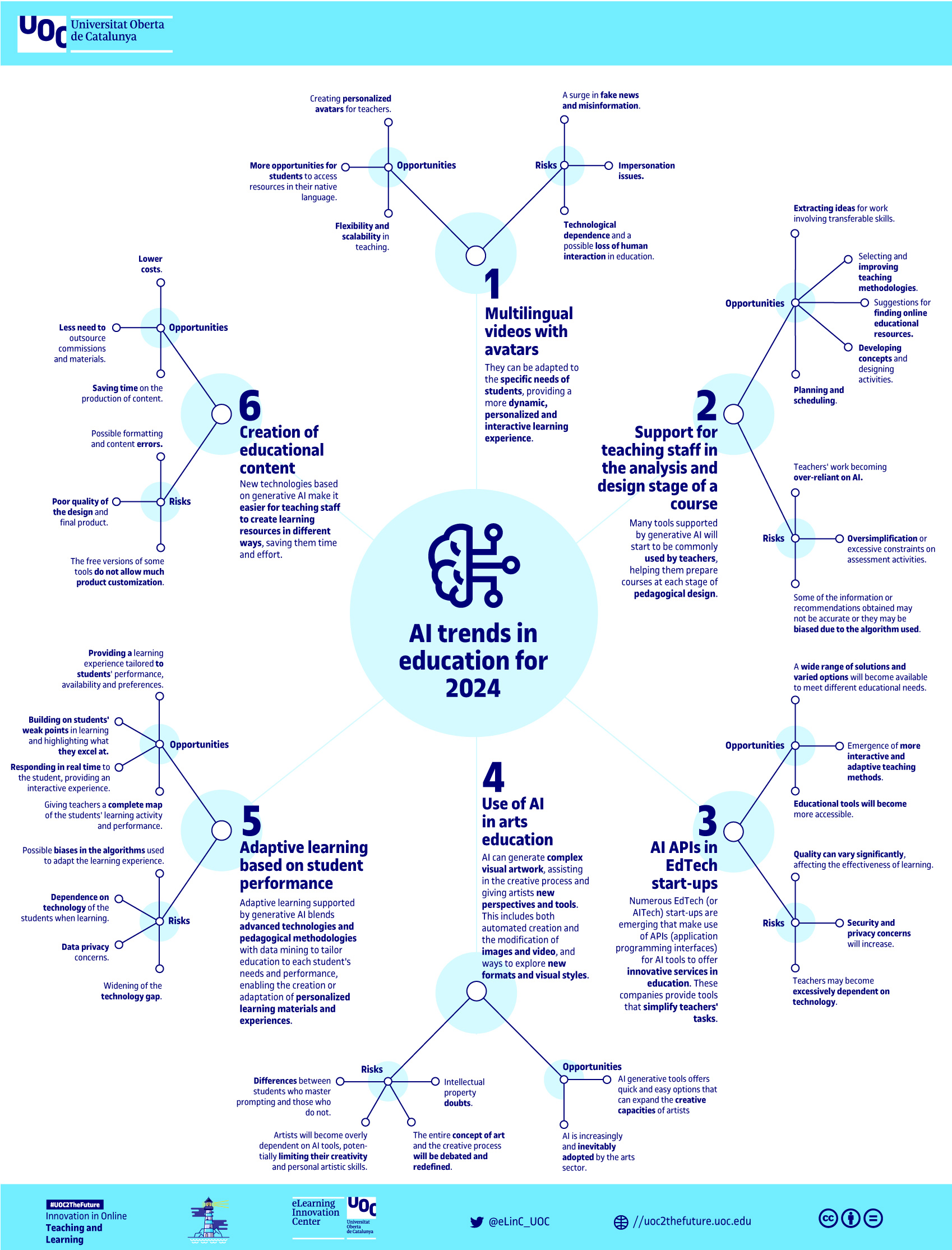The six use cases of AI in classrooms that will change education in 2024
New content generation tools will lead to education that is more innovative and flexible, and tailored to the student's needs
The proliferation of new generative artificial intelligence (AI) tools has led to disruptions in various areas, including the landscape of education. The popularity and ease of use of these technologies, combined with the enormous potential they offer, has led to a series of tools and applications which mean we have to reconsider pedagogical development. Desirée Gómez Cardosa and Guillem Garcia Brustenga, experts in trend spotting and analysis at the Universitat Oberta de Catalunya's (UOC) eLearning Innovation Center (eLinC), highlight the main trends related to AI in the educational sphere which we will see in the classroom in the year to come. These changes will provide new opportunities for improving the educational process, but also entail risks that must be taken into account.
“These trends show that generative AI can be a very powerful and transformative tool, but it also poses significant challenges”
1. Avatars in multiple languages
One of the most dramatic changes will be the widespread use of AI to create videos of avatars, featuring real or fictional people, which use natural language in various tongues. Using production tools such as HeyGen or Synthesia, these computer-generated representations of human beings will help provide a more personalized and accessible educational experience on a global scale. For example, they will enable teachers to create their own avatars that teach in their students' native language, even if they do not really speak it themselves.
2. Course preparation
Another new factor to take into account will be how teaching staff use this generative technology to prepare their courses at various stages in the educational process. Conversational tools, such as ChatGPT, or tools, like ChatPDF, will help them to plan their course, search for and index information, outline methodological proposals, and suggest online educational resources, among other things.
3. Services for education through APIs
There is also a growing interest in pushing the use of AI in teaching thanks to specialist start-ups developing APIs for use in education. These application programming interfaces (APIs) for artificial intelligence tools provide innovative and specific services for education. This opens up the possibility of adding some degree of automation to tasks including content creation, student assessment or class management. New applications are also being developed to allow any user to create personalized AI educational tools, thereby enhancing the democratization of assisted learning.
4. Integration in art courses
The fourth trend is related to the inevitable integration of AI in art courses as a creative tool for producing innovative and previously impossible works, or assisting in the creative process. Midjourney, DALL·E and Runway are some of the platforms that already allow users to create images and video in order to produce highly complex works of visual art, and they are widely used by an ever-increasing number of professionals specializing in these artistic fields.
5. Personalized learning experiences
Adaptive learning based on AI and the student's actions will reach the education sector in the form of a combination of advanced technologies and pedagogical methodologies based on data exploitation. The objective is to optimize education based on each student's unique needs and progress, enabling materials and learning experiences to be created or adapted in a personalized way.
6. Infographics, presentations, and glossaries: time and cost savings
Finally, the last trend is related to creating learning resources in different ways, and reducing the work involved in producing them. These possibilities include support when structuring, devising and creating infographics, creating slideshows with tools such as SlidesAI or Tome, and contributing to the creation of glossaries. This will all help teachers reduce outsourcing and costs, and the time spent on producing content.
"We're entering an exciting time in the field of education, because generative AI is a gateway to personalized and global learning. However, it's imperative to address the ethical risks involved and ensure that these new technologies are used responsibly. We must foster AI literacy and equitable access to reduce the digital divide that it could lead to," said Desirée Gómez Cardosa, a Learning and Teaching analyst at the eLinC.
Warnings and dangers
The authors warn that automating certain processes and delegating decisions to artificial intelligence may involve risks as well as benefits. They highlight a possible excessive delegation of teachers' work to AI, the danger of algorithm biases which affect the quality of the materials produced, and the possibility that given the boom in the sector and the emergence of new agents, personal data may be at risk. There are also more specific risks, such as the fact that the sophisticated nature of the tools used to create avatars and replicate voices can lead to misinformation and identity theft, and the integration of AI in the artistic process raising doubts as to how to determine intellectual property, which may lead to a redefinition of the concept of the creative process.
"These trends show that generative AI can be a very powerful and transformative tool, but it also poses significant challenges and we cannot allow ourselves to become overly dependent and by doing so diminish the value of human interaction and critical thinking in education. Collaboration between teaching staff, students and developers will be crucial if these new tools are to be successfully integrated into education. Striking a balance between technology and humanity will be essential for fully harnessing the potential of AI," concluded Guillem Garcia Brustenga, co-author of the study.
UOC R&I
The UOC's research and innovation (R&I) is helping overcome pressing challenges faced by global societies in the 21st century by studying interactions between technology and human & social sciences with a specific focus on the network society, e-learning and e-health.
Over 500 researchers and more than 50 research groups work in the UOC's seven faculties, its eLearning Research programme and its two research centres: the Internet Interdisciplinary Institute (IN3) and the eHealth Center (eHC).
The university also develops online learning innovations at its eLearning Innovation Center (eLinC), as well as UOC community entrepreneurship and knowledge transfer via the Hubbik platform.
Open knowledge and the goals of the United Nations 2030 Agenda for Sustainable Development serve as strategic pillars for the UOC's teaching, research and innovation. More information: research.uoc.edu.
Experts UOC
Press contact
-
Sònia Armengou

